It doesn’t take much for me to be intrigued by any piece of media. If a book has a nice cover, I’m probably going to want to at least read the description on the back of it. If a movie has a good soundtrack, I may be convinced to watch it. And if a game has interesting graphics or some gameplay gimmick that stands out, I’ll be more inclined to try it on my own time. The latter is where I found myself a couple days ago. One of the streamers I watch more regularly plays a lot of weird games from all corners of the internet, and in this particular video he happened to be playing one simply titled Everything is going to be OK. With a title like that, accompanied by distorted graphics that look like they could come from a horror story, it’s easy to jump to the conclusion that no, everything was not going to be okay. Yet though I expected a creepypasta-esque game in which there’s a cult and everything is terrible forever, the game itself had none of the horror trappings that I had grown so used to from staples like “Ben drowned” or even the Silent Hill series. Upon downloading and playing the early access version of the game myself–I stopped watching the stream so I wouldn’t completely ruin the experience–I found I was completely wrong altogether. Everything is going to be OK isn’t a horror game. It’s more like slice-of-life, and its message is ultimately positive.
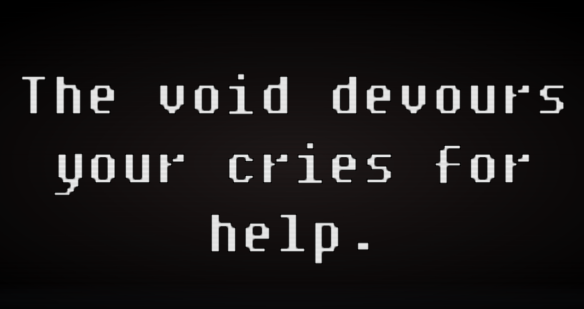
No, I promise. (screenshot taken by me)
TW for cartoon gore and discussions of depression and anxiety beneath the cut.
It wasn’t until I was sitting in the game’s aftermath that I looked into creator Nathalie Lawhead’s thoughts on the game and what she was trying to achieve with it. “Slice-of-life”, as a video game genre, would more than likely bring up images of farming games, Animal Crossing, or maybe even dating sims and visual novels. As Everything is going to be OK is so drastically different from these initial thoughts, and without the linear narrative that many of those games have, the game may seem confusing an unapproachable to some. Lawhead, instead, reveals the goals she had for this game as follows:
[Everything is going to be OK is] a collection of very abstract life experiences, things I felt while going through hard times, and how I felt, or moved on, afterward.
A lot of it is presented via humor, or creates ridiculous circumstances, because I feel like life is ridiculous. It’s one damn thing after the other and after a while there’s nothing left to do but laugh at it. Humor is what helps take the edge off, perhaps even create a platform for transcendence.
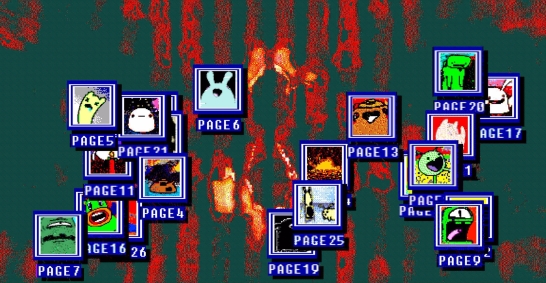
(Screenshot taken by me)
In a lot of ways, I found that Everything is going to be OK is a close sibling to Zoe Quinn’s Depression Quest, but in this case it’s its very absurd, bright, and equally unapologetic sibling. Everything is going to be OK is quote-unquote advertised as an “interactive zine”; its overworld is a collection of icons labeled as pages, distinguished with images that only make sense after you’ve experienced what’s on the page. Each page is a mini-game that ranges from a WASD-controlled romp through a crowd of creatures not wanting to be your friend to clicking on hearts to stave off the apocalypse for one second longer. Many of the games have to do with trying to make the best out of a bad situation, and many of them can end up with the cute little bunny-like avatars dying. Personally I did find several of the games humorous in that sort of “oh my god” way that follows a funny animal video about an older cat pushing kittens off a shelf, but there were a few other games that resonated with me so deeply that I felt like crying as I played through them.
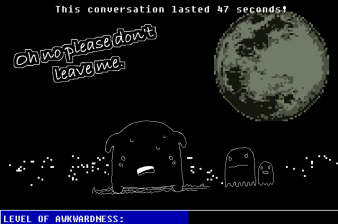
(Screenshot taken by me)
Three of these pages stuck out to me the most. Page 18 is all about the persistent anxiety of socializing with other people. While the cute animal the player controls is excited to join in the ultimately confusing and unimportant conversation happening around them, it’s all too easy for the conversation to be ruined. The game here is that in the break in conversation, the player must choose from a selection of equally bizarre options (ranging from simple one word responses like colors to nonsensical phrases like “dust with probably dust”) among which lies the presumably only one option that will keep the conversation going. Get it right, and you’re rewarded with your conversation partners agreeing with your point. Get it wrong and you’re chastised for being rude and changing the topic, as well as adding quite a few points to the awkwardness meter at the bottom of the screen.
This same player avatar shows up again in Page 19 and is still trying to make friends. As the large rabbit creature walks through seemingly endless scenes, their pleas for someone to be friends with them are met only with the other creatures screaming and running away from them, until at the very end the rabbit creature is taken away by a tentacle monster, declaring that “I…. don’t need to be loved any more.” I think many people with social anxiety can relate to these two scenarios: it feels like anything you can possibly say will ruin the conversation and make people angry at you, and it’s more preferable to stop trying to make friends and instead opt for being alone and maybe even coming to love yourself than depend on others for that reassurance.
The page that hit me the hardest, however, is Page 7. If you’ve read my review of The Beginner’s Guide, then you already know that games that explore depression hit me real hard. Page 7 features a green creature who is unknowingly infected by a parasite who whispers terrible things to them. The game is the player trying to comfort the creature by picking from several options. Sometimes the creature is affected by this, smiles for a moment, and a heart floats from them in thanks. Other times, the parasite takes over, saying things like “we’re not pretty enough to love” or “just give up”, making the creature cry out in sorrow and frown in exhaustion. The creature never “gets better”; you can’t get enough hearts in a row to make the parasite leave. And one bad answer changes the creature forever–once they begin to frown, they never return to the neutral expression they start out with. The page’s victory screen is a blue box that says “YOU DID GOOD. Everything is okay” along with a motivational poster that reads “You Win. It’s OK to settle.”
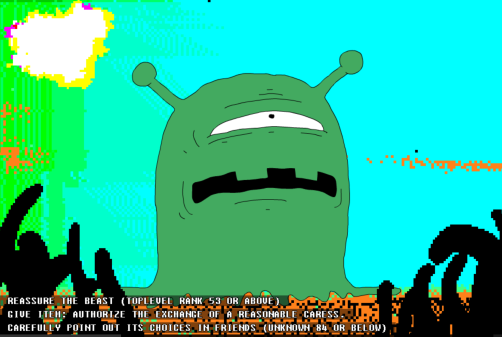
Where did Lawhead get this video of me? (Screenshot taken by me)
Humor is by all means an effective way of dealing with depression and other issues, but to me, the kind way in which the game lifts up the efforts of its creatures is the most impactful aspect of the game as a whole. This decade is just escaping the trappings of the previous era where one of the most marketable design choices was to utilize cute animals and other creatures and juxtaposition them against mean sayings, a la those “Boys are stupid. Throw rocks at them” rabbits from the early 2000s. At first glance Lawhead’s work gives the impression that it may utilize this same styling: that these cute things are actually cruel and that’s just the way things are. Imagine my surprise when instead of the game laughing at me because I dared to try and make these creatures happy like I expected, it did the exact opposite. Though there was plenty of disturbing, un-nice thing to go around, nothing about it was cruel; the shock of being told “you did good” or “this is okay, too” in this sort of environment felt all the more impactful. After all, not everyone can get over their anxieties or depression; for many, things being “okay” and acceptable are the best they can get. And that isn’t worth any less than a “happy ending”.
Of course, there’s a layer beyond what’s immediately accessible to players. Once more, Lawhead explains,
[This game is] oddly enough my own version of a power-fantasy. I have come to think that we have a backward idea of power, and perception of strength. We always have, and I think this is a byproduct of a historically patriarchal system. From religion, to politics, to economics, power is viewed as how many people you can subjugate. Respect is how many people fear you because of your power. How you can get what you want at the expense of others, how you are the biggest dog in the dog-eat-dog world that we have created for ourselves…
…We don’t really have a concept, in our culture, or discussion about alternative views of power from a survivor’s standpoint. How is it like for survivors? Are people that live with trauma strong? Are people with mental disorders, or PTSD strong? Why is suicide seen as selfish and weak, when the person that lived with it got as far as they did? We don’t popularly view survivors, victims, traumas, etc, as strength. It is a weakness, and I don’t like that.”
While I believe this is something we all think about on some level, it’s definitely easy to get swept away in more bombastic representations of power fantasies. If you’re a survivor in a video game, that usually means you have huge muscles, a big gun, and you’re ready to take down the forces that oppressed you one person at a time. You may be a survivor, but you–as the character–don’t actually deal with the process of “surviving”. What’s for you after you take down the big bad? Who knows. Is the implied happy ending really going to lead to happiness? Again, who knows. Our media doesn’t usually make a point of exploring this aspect of trauma and gets just as far as showing what badasses our trauma can make us. And this… isn’t exactly the most accessible message.
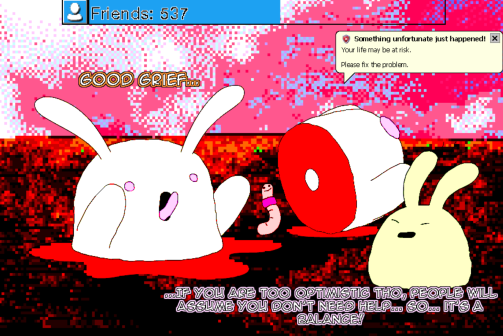
(Screenshot taken by me.)
People shouldn’t have to wield their trauma like a weapon in order to be considered worthy of positive reinforcement. Page 17 introduces us to a rabbit who gets themselves into a sticky situation of being cut in half. The goal of the mini-game is to garner as many intangible friends as possible (until the bar is filled) by crying out for help into the void. Sometimes you gain friends, sometimes you lose them. The clear correlation here is to people “crying for attention” on social media platforms like Twitter and Facebook. It’s so easy to look at these people in real life and feel disgust or annoyance. Why are they asking for help? Shouldn’t they just suck it up? But really, doesn’t it take a strong person to put themselves and their vulnerabilities out there for everyone to see? Everything is going to be OK praises the efforts of people who try to cope by putting themselves out there. Lawhead knows all too well that trying to live past traumatic events and keeping going against the convincing words of depression and anxiety isn’t a glorious path to victory carved from the mental disorders we decimated on the way. Sometimes we’re going to fail, and that’s all right. Sometimes settling is the best option, and that doesn’t make the people who do settle any weaker or less worthy of praise, comfort, and love than those who try to live up to the machismo inspired “beat your demons ‘til they’re black and blue” way of thought.
Even if you don’t necessarily agree with Lawhead on her art, it’s baffling to me how many people are ready to dismiss it entirely. I’ve seen many comments on YouTube (yes, I know, “Don’t read the comments”) that say they can relate, then immediately go back on that when reading that Lawhead is writing against the (western) patriarchal society many of us have grown up in. As if “femminizms r ruinin muh gamez”. These comments prove to me even more than a game like Everything is going to be OK needs to be made, and more games like it need to be made, too. Both Zoe Quinn and Depression Quest were attacked and questioned about their necessity and/or importance in the gaming sphere, and going by Lawhead’s comments on her experience after releasing the early access of Everything is going to be OK she’s facing the same thing (though hopefully on a much smaller scale). So I just want to say here that even if you, reader, are maybe put off by this game a bit, you should give it a try. It’s definitely not for everyone, but its rawness and genuine compassion deserve to be experienced. You can try Everything is going to be OK’s early access version here at Game Jolt. (You can download it for free, but I encourage you to take the “name your own price” option and send some money her way.)
Follow Lady Geek Girl and Friends on Twitter, Tumblr, and Facebook!

Great piece!